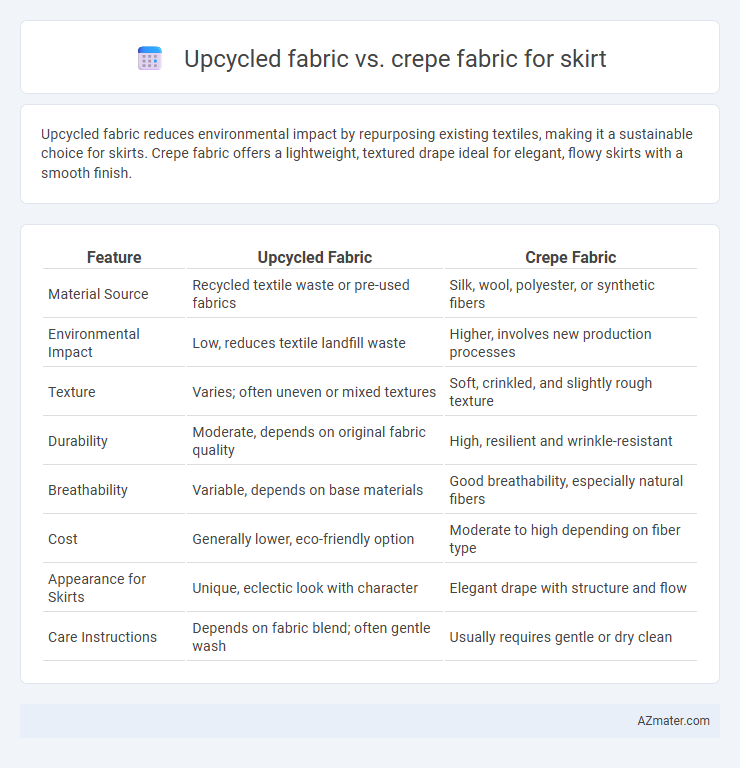Upcycled fabric reduces environmental impact by repurposing existing textiles, making it a sustainable choice for skirts. Crepe fabric offers a lightweight, textured drape ideal for elegant, flowy skirts with a smooth finish.
Table of Comparison
| Feature | Upcycled Fabric | Crepe Fabric |
|---|---|---|
| Material Source | Recycled textile waste or pre-used fabrics | Silk, wool, polyester, or synthetic fibers |
| Environmental Impact | Low, reduces textile landfill waste | Higher, involves new production processes |
| Texture | Varies; often uneven or mixed textures | Soft, crinkled, and slightly rough texture |
| Durability | Moderate, depends on original fabric quality | High, resilient and wrinkle-resistant |
| Breathability | Variable, depends on base materials | Good breathability, especially natural fibers |
| Cost | Generally lower, eco-friendly option | Moderate to high depending on fiber type |
| Appearance for Skirts | Unique, eclectic look with character | Elegant drape with structure and flow |
| Care Instructions | Depends on fabric blend; often gentle wash | Usually requires gentle or dry clean |
Understanding Upcycled Fabric: Definition and Benefits
Upcycled fabric for skirts involves repurposing pre-existing textile materials to create new garments, reducing waste and environmental impact. This sustainable choice offers unique textures and patterns, often resulting in one-of-a-kind pieces that contrast with the smooth, lightweight, and slightly crinkled texture of crepe fabric. Embracing upcycled fabric supports eco-friendly fashion by minimizing resource consumption and promoting circular economy principles.
What is Crepe Fabric? Characteristics and Uses
Crepe fabric is a lightweight, textured material known for its slightly crinkled or pebbled surface created by twisted yarns, offering excellent drape and a matte finish. It is commonly made from silk, wool, polyester, or cotton and is favored in skirt designs for its fluid movement, wrinkle resistance, and elegant appearance. Crepe fabric is ideal for formal and casual skirts, providing comfort with a sophisticated look that adapts well to pleats, gathers, and flowing silhouettes.
Environmental Impact: Upcycled vs Crepe Fabric
Upcycled fabric for skirts significantly reduces waste by repurposing discarded textile materials, minimizing landfill contributions and lowering carbon emissions compared to traditional fabric production. Crepe fabric, typically made from polyester or viscose, involves resource-intensive processes and chemical treatments that elevate its environmental footprint. Choosing upcycled fabric supports sustainable fashion initiatives by conserving resources and promoting circular economy practices.
Aesthetic Differences: Texture and Appearance
Upcycled fabric for skirts often showcases a unique, artisanal texture with visible variations and patchwork elements, creating a distinct, eco-conscious aesthetic. Crepe fabric, characterized by its finely crushed, slightly crinkled surface, offers a smooth, elegant drape that enhances formal or refined skirt designs. The tactile contrast between upcycled fabric's rustic, textured charm and crepe's sleek, sophisticated appearance defines their key aesthetic differences in skirt fashion.
Durability and Longevity: Which Fabric Lasts Longer?
Upcycled fabric, often made from reclaimed textiles, varies in durability depending on the original material but generally offers good longevity due to its pre-washed and reinforced fibers. Crepe fabric, known for its distinctive crinkled texture, is typically made from silk, wool, or synthetic fibers, and provides moderate durability but may show wear faster with frequent use. For skirts requiring long-lasting wear, high-quality upcycled fabric tends to outperform crepe fabric in terms of durability and resistance to everyday wear and tear.
Comfort and Wearability: Upcycled Fabric vs Crepe Skirts
Upcycled fabric skirts offer unique breathability and softness derived from recycled textiles, enhancing comfort for everyday wear. Crepe fabric skirts provide a lightweight, slightly textured feel that drapes elegantly and allows for ease of movement. Both materials balance comfort and wearability, with upcycled fabrics emphasizing eco-friendly durability and crepe focusing on smooth, flowing silhouette appeal.
Maintenance and Care Requirements
Upcycled fabric skirts demand gentle washing with mild detergents to prevent damage to reclaimed fibers, often requiring air drying to maintain texture and durability. Crepe fabric skirts, known for their delicate, crinkled texture, typically need dry cleaning or hand washing in cold water to preserve the fabric's flow and avoid shrinkage. Both materials benefit from low-heat ironing or steaming to remove wrinkles while ensuring longevity and aesthetic appeal.
Cost Comparison: Upcycled vs Crepe Skirts
Upcycled skirts generally offer a more budget-friendly option, as they repurpose existing materials, reducing raw fabric costs significantly compared to crepe skirts made from new, specialized fabric. Crepe fabric, known for its textured surface and luxurious drape, tends to have higher production and purchase costs, reflecting quality and consistent appearance. The cost difference can range from 20% to 50%, making upcycled skirts a sustainable and economical choice without compromising style.
Fashion Versatility: Styling Skirts with Both Fabrics
Upcycled fabric offers unique texture and pattern variations that enhance the fashion versatility of skirts by allowing creative, eco-conscious styling options. Crepe fabric provides a smooth, flowing drape ideal for elegant and sophisticated skirt designs, perfect for formal or office wear. Both fabrics support diverse looks, with upcycled fabric lending a bold, artisanal touch and crepe fabric ensuring timeless, polished silhouettes.
Choosing the Right Fabric: Decision Guide for Conscious Shoppers
Upcycled fabric offers an eco-friendly choice by repurposing materials, reducing waste, and supporting sustainable fashion, ideal for skirts with unique textures and stories. Crepe fabric is known for its lightweight, breathable quality and elegant drape, perfect for skirts requiring fluid movement and a polished finish. Conscious shoppers should balance sustainability goals with desired fabric performance, considering durability, feel, and environmental impact when selecting between upcycled and crepe fabrics.

Infographic: Upcycled fabric vs Crepe fabric for Skirt
 azmater.com
azmater.com